What more than this could be said for such an hypothesis? Here, probably, is its charm, and its strong hold upon the speculative mind. Unproven though it be, and cumbered prima facie with cumulative improbabilities as it proceeds, yet it singularly accords with great classes of facts otherwise insulated and enigmatic, and explains many things which are thus far utterly inexplicable upon any other scientific assumption.
We have said that Darwin’s hypothesis is the natural complement to Lyell’s uniformitarian theory in physical geology. It is for the organic world what that is for the inorganic; and the accepters of the latter stand in a position from which to regard the former in the most favorable light. Wherefore the rumor that the cautious Lyell himself has adopted the Darwinian hypothesis need not surprise us. The two views are made for each other, and, like the two counterpart pictures for the stereoscope, when brought together, combine into one apparently solid whole.
If we allow, with Pictet, that Darwin’s theory will very well serve for all that concerns the present epoch of the world’s history—an epoch in which this renowned paleontologist includes the diluvial or quaternary period—then Darwin’s first and foremost need in his onward course is a practicable road from this into and through the tertiary period, the intervening region between the comparatively near and the far remote past. Here Lyell’s doctrine paves the way, by showing that in the physical geology there is no general or absolute break between the two, probably no greater between the latest tertiary and the quaternary period than between the latter and the present time. So far, the Lyellian view is, we suppose, generally concurred in. It is largely admitted that numerous tertiary species have continued down into the quaternary, and many of them to the present time. A goodly percentage of the earlier and nearly half of the later tertiary mollusca, according to Des Hayes, Lye!!, and, if we mistake not, Bronn, still live. This identification, however, is now questioned by a naturalist of the very highest authority. But, in its bearings on the new theory,




